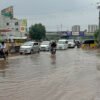BUNER: Residents of Buner district where devastating floods have killed more than 200 people said on Monday they were too scared to go back to their deluged homes as authorities warned of more rains to come.
“Everybody is scared. Children are scared. They cannot sleep,” said Sahil Khan, a 24-year-old university student.
He was speaking to a Reuters team from a rooftop in the district of Buner, where he and 15 other villagers had climbed to escape any more flooding amid a fresh spell of rain.
“It was like a doomsday scenario,” he said of the flash floods caused by heavy rains and cloudbursts that, according to the Provincial Disaster Management Authority, have killed at least 341 people in the northwest since Friday – more than 200 of them in Buner.
The fatalities include 28 women and 21 children, it said.
The intense rain has claimed lives and spread destruction in several northern districts, with most people killed in flash floods, according to the National Disaster Management Authority.
In hilly areas, the floods washed away houses, buildings, vehicles and belongings.
Buner district was the worst hit in northwestern Khyber Pakhtunkhwa province.
Khan and other residents in Buner’s Bayshonai Kalay village fled to higher ground when a water channel that had earlier overflowed and caused major devastation started swelling with more rain on Monday, according to Reuters witnesses.
He and several other residents said most of the villagers were staying with relatives or in makeshift camps set up by local authorities on higher ground.
Rescuers were finding it difficult to get heavy machinery into narrow streets.
In Buner’s main markets and streets, shops and houses were buried in up to five feet of mud, which locals were clearing with shovels. Elsewhere, cars and other belongings were strewn in the rubble of ruined buildings.
“People are out of their homes. They are fearful,” said Dayar Khan, 26, a shopkeeper in Buner. “They have climbed up in the mountains.”
Rescue and relief efforts resumed in the flood-hit areas several hours after heavy rain forced rescuers to halt work on Monday, a regional government officer, Abid Wazir, told Reuters.
“Our priority is now to clear the roads, set up bridges and bring relief to the affected people,” he said.
Heavy rains and flash floods also hit more areas in the northwestern province on Monday, including Swabi district, where 11 people were killed, according to the provincial disaster management authority.
The flash floods hit a remote mountainous region in Daroli Bala, local district commissioner Nisar Khan told Reuters, which caused houses to collapse.
It took several hours for rescue teams to access the remote area, he said, adding that he also went to the region where residents reported that their relatives were missing.
“The relatives and family members told us that 40 people have been swept away,” he said.
Lieutenant General Inam Haider Malik, the National Disaster Management Authority’s chairman, warned of two more spells of rain between August 21 and September 10.
“It can intensify,” he said, and there could be more cloudbursts.
Syed Muhammad Tayyab Shah, who leads risk assessment at the authority, said global warming had changed the pattern of the annual monsoon, pushing it around 100km west of its normal path.
Relief supplies, including food, medicine, blankets, tents, an electric generator and pumps have been sent to the affected areas, the authority said.
Officials said Buner was hit by a cloudburst, a rare phenomenon where more than 100mm (4 inches) of rain falls within an hour in a small area. In Buner, there was more than 150 mm of rain within an hour on Friday morning.
“The current weather system is active over the Pakistan region and may cause heavy to very heavy rainfall during the next 24 hours,” the disaster authority said on Sunday.
Torrential rains and flooding this monsoon season have killed 660 people across the country since late June, it said.



